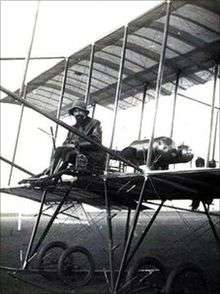Giulio Gavotti

Giulio Gavotti (17 October 1882 in Genoa – 6 October 1939) was an Italian lieutenant and pilot, who fought in the Italo-Turkish War. He set two firsts in the history of aerial warfare of heavier-than-air flyers: he was the first man to make an aerial bombardment, as well as the first to perform a night mission.
Aerial bombardment
On 1 November 1911, he flew his early model Etrich Taube monoplane against Ottoman military in Libya.[1][2][3] He took four grenades ("Cipelli"[3]) to a leather pouch, each of a size of grapefruit and weighing about four pounds.[2] Flying at an altitude of 600 feet, Gavotti screwed in the detonators and tossed each munition over the side[1] — three onto the Tagiura (Jagiura) oasis, and one more onto military camp at Ain Zara.[2][3] Gavotti’s attack did not inflict any casualties.[4]
The oldest known preserved Etrich Taube, in Vienna, Austria, is possibly a near-twin to the aircraft Gavotti flew in 1911, as both are said to have been powered with inline-four cylinder liquid-cooled powerplants.
After this and further missions, the Ottoman Empire issued a protest. The dropping of bombs from balloons had been outlawed by the Hague Convention of 1899, but Italy argued that this ban did not extend to heavier-than-air craft.[1]
Night mission
Gavotti performed the historically first night mission of a heavier-than-air aircraft. It took place as part of the same campaign in Libya on 4 March 1912.[5]